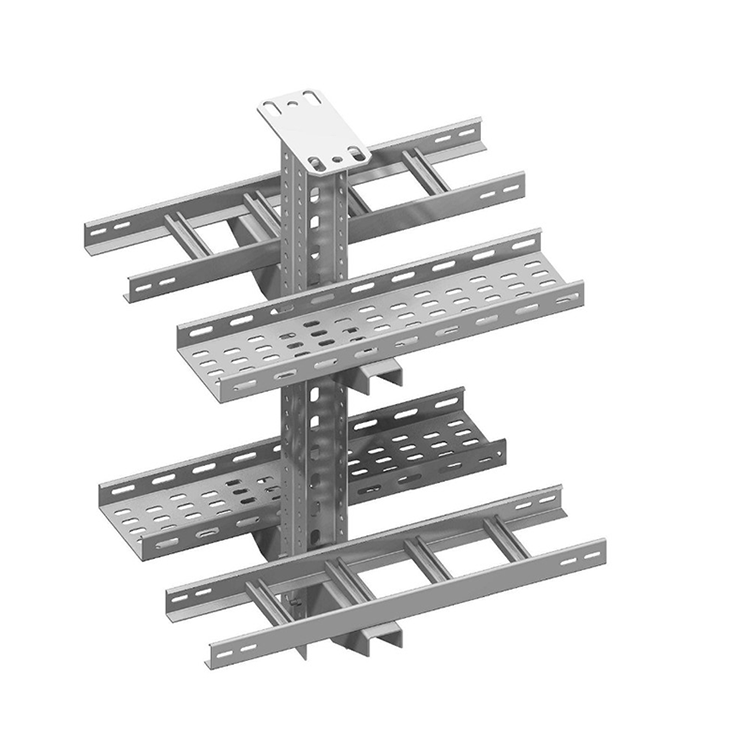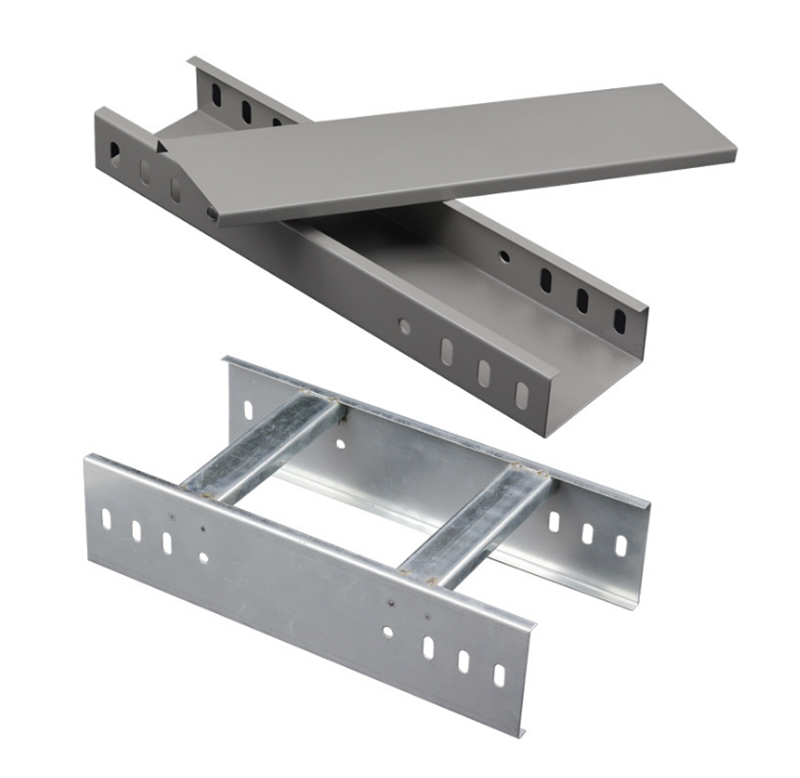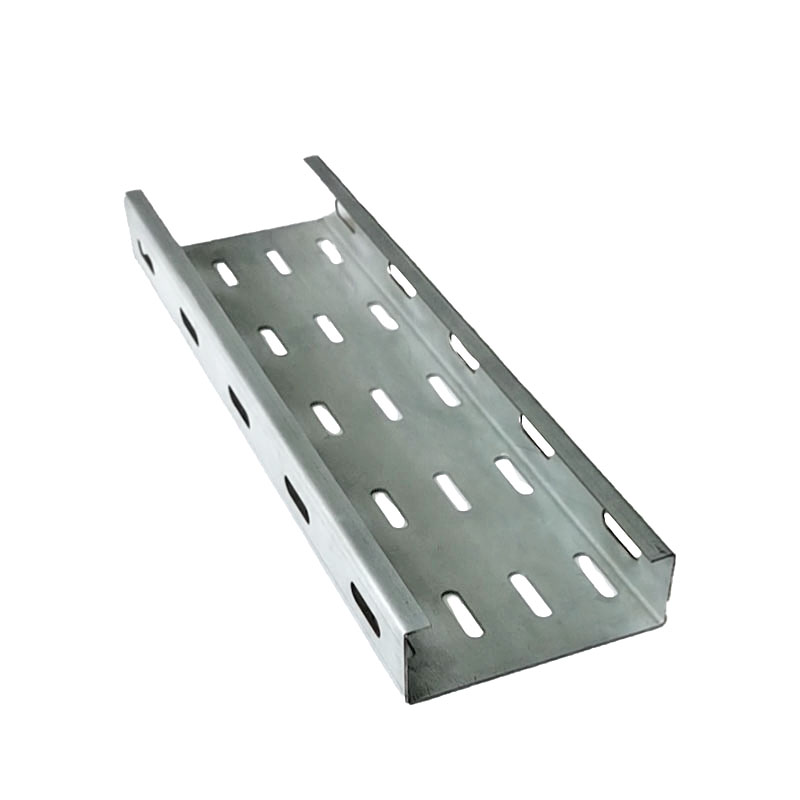Cable Ladders vs. Cable Trays
Technical Comparison Guide for Industrial Cable Management Solutions
Fundamental Design Differences
| Feature | Cable Ladders | Cable Trays |
|---|---|---|
| Structure | Parallel rails with transverse rungs | Single-sheet metal with slots |
| Base Type | Open rungs (≥30% ventilation) | Perforated/slotted base |
| Load Capacity | Heavy-duty (500+ kg/m) | Medium-duty (100-300 kg/m) |
| Typical Spans | 3-6m between supports | ≤3m between supports |
| EMI Shielding | None (open design) | Partial (25-50% coverage) |
| Cable Accessibility | Full 360° access | Limited side access |
Cable Ladders: Heavy-Duty Infrastructure Solution
Technical Specifications
- Materials: Hot-dip galvanized steel or aluminum alloys
- Rung spacing: 225-300mm (standard), customizable to 150mm
- Ventilation efficiency: ≥95% open area ratio
- Temperature tolerance: -40°C to +120°C
Key Advantages
- Superior load distribution for cables up to 400mm diameter
- Reduces cable operating temperatures by 15-20°C
- Modular components for vertical/horizontal configurations
- Tool-free access reduces modification downtime by 40-60%
Industrial Applications
- Power plants: Main feeder lines between transformers and switchgear
- Wind farms: Tower cabling systems (nacelle-to-base)
- Petrochemical facilities: High-current supply lines
- Data centers: Overhead backbone cabling for 400Gbps fiber
- Industrial manufacturing: Heavy machinery power distribution
- Transportation hubs: High-capacity power transmission
Cable Trays: Precision Cable Management
Technical Specifications
- Materials: Pre-galvanized steel, 316 stainless steel, or composites
- Perforation patterns: 25x50mm slots or 10x20mm micro-perfs
- Side rail height: 50-150mm (containment grade)
- Special features: UV-resistant coatings available
Functional Advantages
- 20-30dB RF attenuation for sensitive instrumentation
- Integrated divider systems for power/control/data separation
- Powder-coated finishes (RAL color matching)
- Prevents cable sag exceeding 5mm/m
Application Environments
- Laboratory facilities: NMR/MRI equipment signal lines
- Broadcast studios: Video transmission cabling
- Building automation: Control networks
- Cleanrooms: Pharmaceutical manufacturing
- Retail spaces: POS system cabling
- Healthcare: Patient monitoring systems
Technical Performance Comparison
Thermal Performance
- Cable ladders reduce ampacity derating by 25% in 40°C environments
- Trays require 20% larger cable spacing for equivalent heat dissipation
- Open design maintains cable temperatures 8-12°C lower in high-density installations
Seismic Compliance
- Ladders: OSHPD/IBBC Zone 4 certification (0.6g lateral load)
- Trays: Typically Zone 2-3 certification requiring additional bracing
- Vibration resistance: Ladders withstand 25% higher harmonic frequencies
Corrosion Resistance
- Ladders: HDG coating (85μm) for C5 industrial atmospheres
- Trays: Stainless steel options for marine/coastal installations
- Salt spray resistance: Both systems achieve 1000+ hours in ASTM B117 testing
Selection Guidelines
Choose Cable Ladders When:
- Spanning >3m between supports
- Installing cables >35mm diameter
- Ambient temperatures exceed 50°C
- Future expansion is anticipated
- High cable density requires maximum ventilation
Opt for Cable Trays When:
- EMI-sensitive equipment is present
- Aesthetic requirements dictate visible installation
- Cable weights are <2kg/meter
- Frequent reconfiguration isn’t anticipated
- Small diameter wiring requires containment
Industry Compliance Standards
Both systems meet these critical certifications:
- IEC 61537 (Cable Management Testing)
- BS EN 50174 (Telecommunications Installations)
- NEC Article 392 (Cable Tray Requirements)
- ISO 14644 (Cleanroom ESD Standards)
- ATEX/IECEx (Explosive Atmosphere Certification)
Professional Recommendation
For hybrid installations, use ladders for backbone distribution (≥50mm cables) and trays for final drops to equipment. Always conduct thermal imaging scans during commissioning to verify ampacity compliance.
Engineering Note: Modern composite solutions now combine ladder structural strength with tray containment features – consult specialists for mission-critical applications requiring hybrid performance characteristics.
→ For all products,services and up to date information,please contact us.
Post time: Aug-15-2025



